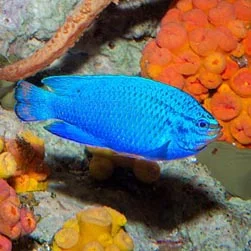Chrysiptera cyanea (Blue Damselfish / Sapphire Damselfish / Blue Devil Damselfish)
• Small fish safe: ✅ Yes
• Small invert safe: ✅ Yes
• Coral safe: ✅ Yes
• Minimum tank size: 75L+ (preferably 100L+ for groups)
• Adult size: ~8 cm (3 inches)
• Diet: Omnivorous (marine pellets, frozen mysis/brine shrimp, algae-based foods)
• Be aware of: Can become territorial and aggressive, especially as they mature. Best kept in small groups in larger tanks to disperse aggression. Juveniles are less aggressive, but adults may become dominant over other fish.
Blue Damselfish (Chrysiptera cyanea) – A Hardy and Vibrant Reef Fish
The Blue Damselfish, also known as the Sapphire Damselfish or Blue Devil Damselfish, is a small, bright blue fishwith a fiery personality. It is one of the hardiest marine fish available, making it a popular choice for both beginner and experienced aquarists. While its striking coloration and energetic behavior make it an attractive addition to reef tanks, its territorial nature requires careful planning when selecting tank mates.
Appearance and Coloration
The Blue Damselfish is one of the most intensely colored reef fish, featuring:
• A deep, electric blue body, which can appear more or less vibrant depending on lighting and mood.
• A yellow to orange-tinted tail in some regional variations (mostly found in males).
• A compact, oval-shaped body with rounded fins, giving it an agile swimming style.
• Juveniles are peaceful and bright blue, while adults may develop darker markings and increased aggression.
This high-energy fish adds a flash of color and movement to any marine tank.
Natural Habitat and Behaviour
Native to the Indo-Pacific, including the Great Barrier Reef, Indonesia, and the Philippines, Blue Damselfish are found in shallow coral reef lagoons and rocky coastal zones, where they:
• Establish small territories, defending them against intruders.
• Form loose social groups as juveniles, but adults become more solitary and dominant.
• Take shelter within coral structures or rock crevices when threatened.
• Can be seen darting in and out of reef formations, displaying quick, defensive movements.
In captivity, they retain their bold, interactive nature, often being the first to investigate new additions to the tank.
Tank Requirements and Water Parameters
Due to their active and territorial nature, Blue Damselfish require adequate space and structure in the aquarium.
• Minimum tank size: 75L+ (100L+ recommended for groups or community tanks)
• Temperature: 24–27°C (75–81°F)
• pH: 8.1–8.4
• Salinity: 1.020–1.025
• Water movement: Moderate to strong
• Filtration: Good filtration and regular water changes to maintain stable water conditions.
A tank with rock formations, caves, and coral structures provides them with natural territories and hiding spaces, helping reduce aggression.
Diet and Feeding
Blue Damselfish are omnivorous and require a balanced diet to maintain their color and energy levels.
Recommended foods include:
• Frozen mysis and brine shrimp – Provides protein.
• High-quality marine pellets and flakes – Look for color-enhancing formulas.
• Algae-based foods and spirulina – Supports digestion and coloration.
• Finely chopped seafood (shrimp, squid, or fish) – Occasional protein treats.
Feed once or twice daily, ensuring they get a mix of protein and plant-based foods for optimal health.
Compatibility and Tank Mates
Blue Damselfish can be territorial, so selecting compatible tank mates is essential.
✔ Peaceful and semi-aggressive tank mates, such as Clownfish, Wrasses, Tangs, and Blennies.
✔ Larger, non-aggressive fish, which can hold their own against minor aggression.
✔ Reef-safe invertebrates, including shrimp, snails, and crabs.
Avoid housing with:
❌ Other highly aggressive fish, such as large Dottybacks or aggressive Triggerfish.
❌ Other small, peaceful fish, such as Firefish or small Gobies, which may be bullied.
❌ Multiple damselfish species, unless in a very large tank with ample hiding spots.
⚠ If keeping a small group, introduce them simultaneously to minimize aggression.
Behavior and Territoriality
Blue Damselfish are bold, fast-moving, and interactive, often being the first fish to:
• Explore new areas of the tank.
• Chase away intruders from their chosen territory.
• Defend food aggressively, particularly during feeding times.
⚠ Mature individuals can become aggressive, particularly in small tanks with limited hiding spaces. Providing plenty of rockwork helps reduce stress and aggression.
Health and Disease Considerations
Blue Damselfish are incredibly hardy, but they can be susceptible to:
• Marine Ich (Cryptocaryon irritans) – Can occur if stressed.
• Bacterial infections – Often due to physical injury from fighting.
• Nutritional deficiencies – Ensure they get a mix of protein and plant-based foods.
To maintain their health:
✔ Provide a balanced diet rich in protein and algae.
✔ Ensure stable water parameters with regular maintenance.
✔ Avoid overcrowding, as aggression can lead to stress and injury.
Lifespan and Long-Term Care
With proper care, Blue Damselfish can live up to 5-7 years, making them a long-term commitment. Their bright color, energetic nature, and resilience make them a fantastic addition to well-planned reef tanks.
Why Choose a Blue Damselfish?
✔ One of the most vividly colored damselfish, with striking electric blue hues.
✔ Hardy and beginner-friendly, adapting well to a wide range of conditions.
✔ Active and entertaining, bringing movement and personality to the tank.
✔ Completely reef-safe, with no risk to corals or invertebrates.
✔ Long lifespan, making them a great long-term addition.
⚠ Important Considerations Before Buying a Blue Damselfish:
🚫 Can be aggressive, particularly in small or crowded tanks.
🚫 May harass smaller, peaceful fish, requiring careful tank mate selection.
🚫 Best introduced last, so they don’t claim the entire tank as their territory.
